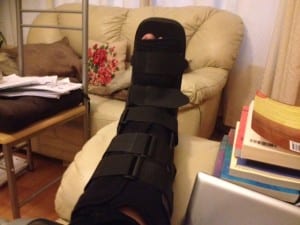It’s been a strange week. Immobilised and restricted; never has the A15 in winter seemed such an attractive prospect. Did I really complain about leaving at 6.15 am and often not getting home till past 7.00 pm? It must have been another life. It was. This is my second week with a broken ankle. I’m trying to be good and R.E.S.T. When I broke a bone in my foot two years ago I walked on it and only stopped when the surgeon threatened to put my whole leg in pot. Half a pot is bad enough. This time I’m booted not potted. It’s heavy and high off the ground making one leg lower than the other. At this rate I’ll have hip trouble too – oh wait, I forgot – I’m supposed to be R.E.S.T.I.N.G.
Time off work and the internet are oxymoronic. This is a 21st century anomaly. I can’t walk but I can use a laptop. Broken bones are not illnesses. They’re huge inconveniences, taking away your independence, making you reliant on family and friends to go anywhere and the Asda online shopping van for wine, but I’m not ill. Frustrated and upset but not ill.
Life carries on regardless. To colleagues on TELEDA I’ve always been an email or a Blackboard learning object. My Internet Outlook keeps most of me connected and phone calls fill in the gaps. I have social media although being home alone you realise there’s not much social about it. What’s missing is real life interaction and digital avatars can never take the place of human bodies. As government and institutions adopt ‘digital first’ policies and ever more public services go online, the future looks bleak in terms of empathy. While I’m out and about I’m the first to appreciate the convenience of the internet for enabling me to fit additional tasks into the day but it’s different when it’s the only form of interaction you have. However, inclusion beats exclusion hands down because it’s digital inclusion which enables to me to stay connected when the other aspects of my life have become broken.
